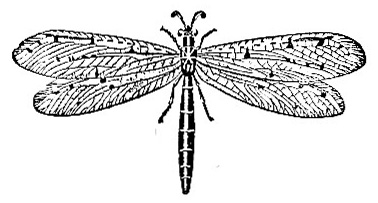1902 Encyclopedia > Ant > Ant Reproduction and Development. Ant Stings. Enemies of Ants. Effects of Poisons on Ants.
Ant
(Part 12)
(B) Familiar Ants (Formica) (cont.)
Ant Reproduction and Development. Ant Stings. Enemies of Ants. Effects of Poisons on Ants.
The reproduction and development of the ordinary ants may be very briefly touched upon in the present notice. The impregnation of the females in their aerial nuptial flight has been already alluded to, as also has the death of the males after the congress. The impregnated females are conveyed to the nest, and the deposition of eggs is proceeded with, the young forms being tended through their larvae and pupae stages by the assiduous neuters. Unlike the bees, several female ants may inhabit the same nest; and the swarming or exodus of the young ants, so far from having for its one and essential object the formation of a new colony, appears to be simply devoted to further reproductive measures. Thus, those that leave the nest are the fresh males and females, the sexual history of which has already been traced; and the nest thus remains a more or lest permanent institution, changing its inmates only in part, and in exceptional circumstances alone giving origin to a new and independent colony.
The stings with which the neuters and females are armed constitute formidable organs of defence. The poison, to which the violent or painful effects of the sting are due, appears to consist of a definite chemical organic compound, the chief acid of which is known by the appropriate name of formic acid, the formula for this compound being CH2O2. Formic acid is also found in the glands attached to the pointed hairs of stinging-nettles. This acid, in itself possessing irritant qualities of a high order, also appears capable of producing even more serious effects when manipulated by chemical means.

Fig. 3 -- Ant Lion (Myrmeleo formicaleo)
The ant-colony, powerful as we have seen it to be, and well protected as it undoubtedly is, is nevertheless subject to the attacks of enemies which wage a successful war against it. Certain species of ants appear to be more subject than others to the attack of such higher forms as they mammalian ant-eaters (Echidna and Myrmecophagidae) and armadillos, as well as to the onslaught of the insect ant-lion (Myrmeleo). The latter literally digs a pit for his victim, in the bottom of which he lies securely hidden ready to devour any unwary ant which may chance to tumble in. And even where the victim is not within actual reach of the Myrmeleo, the latter by means of a shower of sand-particles frequently succeeds in causing it to fall into the snare.
Several substances which have noxious effect upon the ant-colony have been already mentioned. Thus carbolic acid and corrosive sublimate appear to affect the ant-colony as poisonous agents; and solutions of tobacco, lime, soot, and walnut leaves, with urine, are also stated to prove effectual in destroying them, although these latter are decidedly inferior to the two first-mentioned substances.
Corrosive sublimate, indeed, appears to have a curious and even specific action upon these forms, in rendering them actually maniacal, to use a phrase which is applicable generally to the human subject alone. Under the influence even of external contact with this substance, the ants in Grenada during their ravages of last century, were observed to be singularly affected, and were seen even to attack each other with outrageous violence, -- an effect also corroborated of late years in Centrals America by Mr Belt, who saw the rabid ants collected into small balls biting one another, and seizing hold of each other in a most extraordinary fashion under the influence of the mercurial poison. The corrosive sublimate, it is stated, can be effectively used only in dry weather.
Read the rest of this article:
Ant - Table of Contents
|
